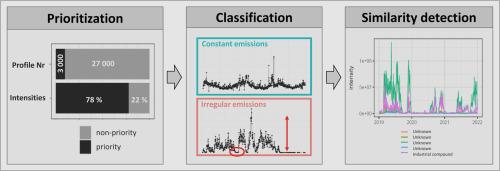Unveiling industrial emissions in a large European river: Insights from data mining of high-frequency measurements
IF 11.4
1区 环境科学与生态学
Q1 ENGINEERING, ENVIRONMENTAL
引用次数: 0
Abstract
Despite the tremendous efforts to improve river water quality, chemical contamination remains a significant issue. Besides well-known contaminants, in recent years, pollutants of industrial origin received increasing attention because of the huge knowledge gap regarding their occurrence, fate and environmental risks. Moreover, such pollutants often exhibit high concentration fluctuations over time, which makes them less predictable and measurable with classical short-time campaigns.This study provides insights into the different sources of chemical contamination of the Rhine River based on temporal high-frequency LC-HRMS monitoring data from a single location. A newly developed prioritization strategy selected nearly 3000 substances as potentially major contaminants. A novel classification analysis based on temporal behavior identified 53% of these compounds (accounting for 62% of the time-integrated intensity recorded in the dataset) as originating from irregular emission sources. Irregular emissions can originate from industrial production cycles. After delimiting other potential irregular sources, we have strong evidence indicating that a considerable share of the irregular emissions likely comes from industrial activities. This finding is supported by the structural elucidation of sixteen irregularly emitted substances, for which the industrial origin was successfully confirmed. Those compounds include 3-chloro-5-(trifluoromethyl)pyridine-2-carboxylic acid and 4-(dimethylamino)-2,2-diphenylpentanenitrile. In addition, 40 other compounds exhibited temporal emission patterns similar to the sixteen industrial compounds, which strongly suggests a common contamination source. Finally, 100 top-ranking compounds were selected for further structural elucidation and emission reduction measures. The computational approach outlined within this study can be effectively applied in other large river catchments to identify unknown contaminants stemming from industrial sources.

揭开欧洲大河工业排放的神秘面纱:高频测量数据挖掘的启示
尽管为改善河流水质做出了巨大努力,但化学污染仍然是一个重要问题。除了众所周知的污染物外,近年来,工业源污染物也受到越来越多的关注,因为人们对这些污染物的发生、归宿和环境风险知之甚少。此外,此类污染物通常会随着时间的推移而出现较高的浓度波动,这使得它们的可预测性和可测量性较低,只能通过传统的短时监测活动来测量。一项新开发的优先排序策略筛选出近 3000 种潜在的主要污染物。基于时间行为的新型分类分析确定了其中 53% 的化合物(占数据集中记录的时间积分强度的 62%)来自非正常排放源。非正常排放可能来自工业生产周期。在界定了其他潜在的不规则排放源后,我们有确凿证据表明,相当一部分不规则排放可能来自工业活动。对 16 种不规则排放物质的结构阐释证实了这一结论,并成功确认了这些物质的工业来源。这些化合物包括 3-氯-5-(三氟甲基)吡啶-2-羧酸和 4-(二甲基氨基)-2,2-二苯基戊腈。此外,还有 40 种化合物的时间排放模式与这 16 种工业化合物相似,这有力地说明了存在共同的污染源。最后,选出了 100 种排名靠前的化合物,用于进一步的结构阐释和减排措施。本研究中概述的计算方法可有效地应用于其他大型河流流域,以识别来自工业污染源的未知污染物。
本文章由计算机程序翻译,如有差异,请以英文原文为准。
求助全文
约1分钟内获得全文
求助全文
来源期刊

Water Research
环境科学-工程:环境
CiteScore
20.80
自引率
9.40%
发文量
1307
审稿时长
38 days
期刊介绍:
Water Research, along with its open access companion journal Water Research X, serves as a platform for publishing original research papers covering various aspects of the science and technology related to the anthropogenic water cycle, water quality, and its management worldwide. The audience targeted by the journal comprises biologists, chemical engineers, chemists, civil engineers, environmental engineers, limnologists, and microbiologists. The scope of the journal include:
•Treatment processes for water and wastewaters (municipal, agricultural, industrial, and on-site treatment), including resource recovery and residuals management;
•Urban hydrology including sewer systems, stormwater management, and green infrastructure;
•Drinking water treatment and distribution;
•Potable and non-potable water reuse;
•Sanitation, public health, and risk assessment;
•Anaerobic digestion, solid and hazardous waste management, including source characterization and the effects and control of leachates and gaseous emissions;
•Contaminants (chemical, microbial, anthropogenic particles such as nanoparticles or microplastics) and related water quality sensing, monitoring, fate, and assessment;
•Anthropogenic impacts on inland, tidal, coastal and urban waters, focusing on surface and ground waters, and point and non-point sources of pollution;
•Environmental restoration, linked to surface water, groundwater and groundwater remediation;
•Analysis of the interfaces between sediments and water, and between water and atmosphere, focusing specifically on anthropogenic impacts;
•Mathematical modelling, systems analysis, machine learning, and beneficial use of big data related to the anthropogenic water cycle;
•Socio-economic, policy, and regulations studies.
 求助内容:
求助内容: 应助结果提醒方式:
应助结果提醒方式:


